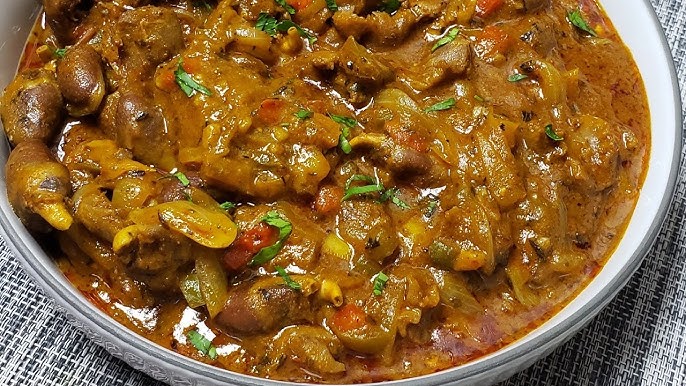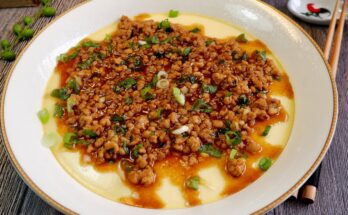Chicken Heart Recipe: Looking for something a little adventurous but packed with flavor? This Chicken Heart Recipe is about to flip your taste buds into full gear. These underrated little morsels are juicy, tender, and bursting with umami—perfect for foodies, keto-dieters, or anyone who loves offal cuisine. Whether you’re pan-frying, grilling, or braising, this guide will walk you through every step of preparing restaurant-quality chicken hearts at home.
What Are Chicken Hearts?
Chicken hearts are exactly what they sound like—the actual hearts of chickens. But before you cringe or scroll away, hear this: they’re a beloved delicacy in many cultures for good reason. Chicken hearts are small, dense, and protein-rich, and they have a mild, meaty flavor with a pleasantly chewy texture when cooked properly. Think of them as the meaty version of a mushroom—firm yet tender and great at soaking up flavor.
In cuisines from Brazil to Japan, they’re skewered and grilled, tossed into stews, or pan-fried with garlic and herbs. What makes them special is not just the taste but the nutritional punch they carry (more on that in a minute). And trust me, once you get over the idea, you’ll wonder why you didn’t start cooking them sooner.
Why You Should Try Cooking Chicken Hearts
So, why chicken hearts? They might not be the star of your local grocery store, but they’re a hidden gem in the culinary world. Here’s why you should absolutely give them a go:
- Affordable: Compared to prime cuts of chicken or beef, hearts are dirt cheap.
- High Protein, Low Fat: Perfect for muscle gain, keto, or low-carb diets.
- Sustainable Eating: Using every part of the animal reduces waste.
- Versatile: They adapt to flavors like garlic, soy, citrus, or spice beautifully.
- Quick to Cook: No need for long hours in the kitchen.
Beyond nutrition and cost, there’s the satisfaction of cooking something unique and making it delicious. Chicken hearts are one of those dishes that impress when done right.
Nutritional Value of Chicken Hearts
Chicken hearts are surprisingly nutritious. These tiny organ meats pack a serious nutritional punch, especially if you’re into fitness, paleo, or keto lifestyles.
Here’s a breakdown per 100g of cooked chicken hearts:
| Nutrient | Amount |
|---|---|
| Calories | ~185 kcal |
| Protein | 26g |
| Fat | 8g |
| Iron | 50% RDI |
| Zinc | 35% RDI |
| Vitamin B12 | 200% RDI |
| Riboflavin (B2) | 80% RDI |
| CoQ10 | Rich Source |
These nutrients support everything from brain health to energy metabolism. Vitamin B12 and CoQ10 are especially important for maintaining stamina and heart health—ironically, from a heart!
Where to Buy Fresh Chicken Hearts
Finding good quality chicken hearts isn’t hard if you know where to look:
- Local Butcher Shops: Your best bet for fresh, properly cleaned chicken hearts.
- Asian or Latin American Markets: These places treat offal as regular food, not novelty items.
- Farmers’ Markets: Great for organic or free-range options.
- Online Meat Suppliers: Many deliver vacuum-sealed chicken hearts straight to your door.
If you’re going with a supermarket, check the frozen meat or offal section. Just make sure there’s no strong ammonia smell—if it smells off, it is off.
How to Clean and Prepare Chicken Hearts
Even if you get pre-cleaned chicken hearts, you’ll still want to do a little prep:
- Rinse under cold water to remove blood clots or residual gunk.
- Trim off the arteries and fat if still attached. You can use kitchen shears for speed.
- Slice in half (optional) if you want faster cooking and better marinade absorption.
- Soak in saltwater or milk (optional) for 15-30 minutes to mellow out the iron flavor.
Pat them dry before cooking—wet hearts won’t sear well and may steam instead.
Kitchen Tools You’ll Need
Nothing fancy required, but having these tools will make life easier:
- Sharp kitchen knife or kitchen shears
- Mixing bowls
- Cutting board
- Heavy-bottomed skillet (cast iron preferred)
- Tongs or spatula
- Paper towels
- Meat thermometer (optional but helpful)
With the right setup, you’ll be turning out perfectly cooked chicken hearts in no time.
List of Ingredients You’ll Need
Basic Ingredients
- 1 lb chicken hearts (cleaned)
- 2 tablespoons olive oil or butter
- 4 garlic cloves (minced)
- Salt and pepper (to taste)
- 1 teaspoon smoked paprika
- 1 teaspoon dried oregano or thyme
- 1 tablespoon soy sauce (for umami)
- Juice of ½ lemon (for zing)
Optional Add-ons for Flavor
- Chili flakes (for spice)
- Cumin or coriander (for depth)
- Onion powder
- Worcestershire sauce
- Fresh parsley or cilantro (garnish)
The beauty of chicken hearts is they’re like flavor sponges—marinate or season well, and they’ll absorb everything.
Step-by-Step Chicken Heart Recipe (Pan-Fried Version)
Step 1: Clean the Chicken Hearts
Rinse them under cold water and trim off excess fat, arteries, or connective tissue. Optionally, slice them in half if you want quicker cooking or easier marination. If you’re sensitive to the strong taste of organ meats, a 30-minute soak in milk or salted water helps mellow things out.
Dry them thoroughly using paper towels. This is key—moisture will ruin your sear and texture.
Step 2: Marinate for Maximum Flavor
In a large mixing bowl, combine:
- 2 tbsp olive oil
- 1 tsp paprika
- 1 tsp oregano
- 1 tbsp soy sauce
- Minced garlic
- Salt and pepper
- Lemon juice
Toss the hearts until evenly coated. Let them sit for at least 30 minutes. If you have more time, cover and refrigerate for up to 2 hours.
This step is the game-changer. The longer they marinate, the deeper the flavor.
Step 3: Heat the Pan Right
When you’re ready to cook, it’s time to get that pan screaming hot. This step is all about building that golden-brown crust that makes pan-fried chicken hearts truly irresistible.
Grab a heavy-bottomed skillet or cast iron pan (they hold heat best) and add about 1 tablespoon of olive oil or butter. Let it heat over medium-high heat until the oil is shimmering. You can test the heat by flicking a drop of water into the pan—if it sizzles and evaporates instantly, you’re good to go.
Do not overcrowd the pan. If you dump in all the hearts at once, they’ll steam instead of sear, and that’s a big no-no. Work in batches if you have to. Lay the chicken hearts in a single layer and let them cook undisturbed for about 2–3 minutes per side.
You want a nice, caramelized exterior while keeping the inside juicy and tender.
Step 4: Sauté to Perfection
After searing both sides, lower the heat to medium and sauté for another 5–6 minutes, tossing occasionally to make sure all sides get golden and cooked through. You’ll notice them shrink slightly as they cook—that’s normal.
The goal is to cook them through without drying them out. Chicken hearts should be firm but tender, not rubbery. If you’re unsure, you can use a meat thermometer. The internal temperature should hit around 160°F (71°C).
You’ll smell the garlicky, savory aroma filling your kitchen—this is when you know you’re on the right track. If things start to stick or brown too fast, deglaze with a splash of water, broth, or wine to lift the flavor bits from the pan.
Step 5: Add Aromatics & Deglaze
Once the hearts are nearly done, toss in a few extra minced garlic cloves, a splash of lemon juice or soy sauce, and maybe a knob of butter for richness. Stir well to coat the hearts in all that garlicky, buttery goodness.
Want a bit of sauce? Add 1/4 cup of chicken broth or white wine and scrape up the browned bits at the bottom. Let it simmer for another minute or two. The hearts will soak up the extra flavor, and your dish gets a light, silky glaze.
At this point, the hearts should be browned, juicy, and coated in flavor-packed pan sauce.
Step 6: Finish with Herbs and Serve
Turn off the heat, sprinkle freshly chopped parsley, cilantro, or green onions on top, and give it one last gentle toss.
Let the hearts rest for a minute before serving—just like steak, it helps redistribute the juices. Now you’re ready to plate!
Serving Suggestions:
- Serve them hot over steamed rice, mashed potatoes, or cauliflower mash.
- Pair with a crunchy side salad or grilled vegetables.
- Skewer them on sticks for a Brazilian-style churrasco vibe.
Either way, you’re in for a savory, protein-packed, wildly underrated meal.
Alternative Cooking Methods
Grilled Chicken Hearts
Marinate the hearts just like in the pan-fry method, then thread them onto skewers. Grill over medium-high heat for about 2–3 minutes per side. You’ll get a nice smoky char and juicy interior—perfect for BBQ nights or appetizers.
Air Fryer Chicken Hearts
Preheat your air fryer to 400°F (200°C). Place the marinated hearts in a single layer and cook for about 10–12 minutes, shaking the basket halfway through. They come out crispy on the outside, tender inside—great for a quick and healthy snack.
Braised Chicken Hearts
Prefer something saucy and tender? Braise the hearts in a flavorful liquid (think tomatoes, garlic, onion, and wine or broth). Simmer on low for 45 minutes to an hour until they become melt-in-your-mouth delicious. Serve with rice or crusty bread.
Flavor Variations and Seasonings
Once you’ve mastered the basic recipe, feel free to get creative with seasonings. Here are some mouthwatering flavor ideas:
- Asian Style: Use soy sauce, ginger, garlic, sesame oil, and a splash of rice vinegar.
- Spicy Cajun: Rub with Cajun seasoning, paprika, cayenne, and black pepper.
- Mediterranean: Marinate in olive oil, lemon juice, garlic, and oregano.
- Sweet and Spicy: Try a glaze of honey, chili flakes, and lime juice.
- Smoky BBQ: Coat in BBQ sauce and grill for a caramelized finish.
These variations help you keep things fresh without getting bored of the same old flavor.
What to Serve With Chicken Hearts
Chicken hearts are surprisingly versatile and pair well with a variety of sides:
- Grains: Steamed jasmine rice, quinoa, couscous, or barley.
- Vegetables: Sautéed greens, roasted Brussels sprouts, or grilled zucchini.
- Starches: Mashed potatoes, sweet potato fries, or polenta.
- Sauces: Chimichurri, garlic aioli, or hot sauce on the side.
Want to make it a full-on feast? Add a side salad and some crusty bread, and you’ve got a gourmet experience.
Tips and Tricks for the Best Chicken Hearts
Want to take your chicken heart recipe from good to downright unforgettable? These kitchen-tested tips will help you master the technique and avoid common pitfalls.
- Dry Thoroughly Before Cooking: Water is the enemy of a good sear. Always pat your chicken hearts completely dry after rinsing.
- Don’t Skip the Marination: Even a 30-minute soak in your favorite marinade makes a massive difference in flavor and tenderness.
- Use High Heat First, Then Lower: Start with a hot pan to get that caramelized crust, then turn the heat down to finish cooking evenly.
- Cut in Half for Even Cooking: Whole hearts are cute, but cutting them in half gives you better texture, quicker cook time, and more flavor absorption.
- Don’t Overcrowd the Pan: If you’re cooking a large batch, do it in rounds. Too many hearts in one pan causes them to steam, not brown.
- Let Them Rest: Just like with steak, resting cooked hearts helps them retain their juices. Give them 2–3 minutes off heat before serving.
One last tip? Don’t be afraid of a little experimentation. Add bold flavors, play with sauces, and try global spices to keep it fun.
Common Mistakes to Avoid
Mistakes happen, especially with unfamiliar cuts like chicken hearts. But once you know what to avoid, you’re golden.
- Overcooking: This is the #1 mistake. Chicken hearts cook fast. Going over the sweet spot turns them rubbery.
- Undercleaning: Leaving behind blood clots or arteries can affect taste and texture. Take a few extra minutes to trim them properly.
- Skipping the Rest Time: Resting isn’t just for big cuts. A short rest allows juices to redistribute, making each bite juicier.
- Using Low Heat the Whole Time: If you don’t start hot, you won’t get that beautiful golden-brown sear.
- No Marination: Straight-up frying raw hearts might save time, but you’ll miss out on deep flavor.
Avoid these, and you’re pretty much guaranteed success—even on your first try.
Storage and Reheating Tips
If you’ve got leftovers (though that’s rare with how tasty these are), here’s how to store and reheat them without turning them into shoe leather.
Storing:
- Fridge: Store in an airtight container for up to 3–4 days.
- Freezer: Freeze cooked chicken hearts in a zip-lock bag or airtight container. They’ll keep for 2–3 months.
Reheating:
- Stovetop: Heat a little oil in a pan and toss the hearts for 2–3 minutes until warmed through. Don’t overcook.
- Microwave: Use short bursts (30 seconds at a time), covered, to avoid drying out.
- Air Fryer: Reheat at 350°F (175°C) for 3–4 minutes for crispy edges.
Pro tip: add a splash of broth or water during reheating to keep them moist and flavorful.
Is It Safe to Eat Chicken Hearts Regularly?
Yes—chicken hearts are not just safe but also beneficial when eaten in moderation. They’re rich in essential nutrients like:
- Iron
- Vitamin B12
- Zinc
- Protein
- Coenzyme Q10 (great for heart health—how fitting!)
That said, organ meats are higher in cholesterol, so if you’re watching that specifically, enjoy them once or twice a week instead of daily.
They’re an excellent source of energy and recovery fuel for athletes, and a great way to add variety to a meat-based or keto lifestyle. Just make sure you’re buying from a reliable source—pasture-raised or organic if possible.
FAQs about Chicken Heart Recipe
1. What do chicken hearts taste like?
Chicken hearts have a rich, meaty flavor, often described as slightly gamey but not overpowering. They’re tender yet slightly chewy, kind of like a cross between dark meat chicken and liver—but milder.
2. Can I cook frozen chicken hearts?
Yes, but it’s best to thaw them first for even cooking and better texture. You can thaw in the fridge overnight or place them in a sealed bag under cold running water for quicker results.
3. How long do chicken hearts last in the fridge?
Raw chicken hearts can be kept in the refrigerator for 1–2 days. Cooked chicken hearts last 3–4 days when stored properly in an airtight container.
4. Are chicken hearts chewy?
They can be if overcooked, but when prepared correctly, they’re tender and juicy with a slight bounce. Marinating helps tenderize them, and cutting in half can reduce chewiness.
5. What cuisines use chicken hearts the most?
Chicken hearts are popular in Brazilian, Japanese, Korean, Filipino, and Russian cuisines. From yakitori in Japan to churrasco in Brazil, they’re a global favorite for those who know how to cook them right.
Final Thoughts
Cooking chicken hearts might sound a bit intimidating at first, but once you’ve tried them, you’ll realize just how flavorful, nutritious, and versatile they are. Whether you’re pan-frying, grilling, or braising, this affordable cut turns into something magical when treated right.
Don’t let their small size fool you—they pack serious flavor and bring a ton of benefits to the table. From high protein and essential nutrients to unique textures and bold tastes, chicken hearts deserve a spot in your kitchen rotation.
So go ahead—buy that pack of hearts, clean them up, marinate them well, and get that pan sizzling. You’ll be surprised at how fast they become a favorite.



